| Solar eclipse of January 26, 2009 | |
|---|---|
 Annularity from Palangka Raya, Indonesia | |
 Map | |
| Type of eclipse | |
| Nature | Annular |
| Gamma | −0.282 |
| Magnitude | 0.9282 |
| Maximum eclipse | |
| Duration | 474 sec (7 m 54 s) |
| Coordinates | 34°06′S 70°12′E / 34.1°S 70.2°E |
| Max. width of band | 280 km (170 mi) |
| Times (UTC) | |
| Greatest eclipse | 7:59:45 |
| References | |
| Saros | 131 (50 of 70) |
| Catalog # (SE5000) | 9527 |
An annular solar eclipse occurred at the Moon's ascending node of the orbit on Monday, January 26, 2009.[1][2] A solar eclipse occurs when the Moon passes between Earth and the Sun, thereby totally or partly obscuring the image of the Sun for a viewer on Earth. An annular solar eclipse occurs when the Moon's apparent diameter is smaller than the Sun's, blocking most of the Sun's light and causing the Sun to look like an annulus (ring). An annular eclipse appears as a partial eclipse over a region of the Earth thousands of kilometres wide. It had a magnitude of 0.9282 and was visible from a narrow corridor beginning in the south Atlantic Ocean and sweeping eastward 900 km south of Africa, slowly curving northeast through the Indian Ocean. Its first landfall was in the Cocos Islands followed by southern Sumatra and western Java. It continued somewhat more easterly across central Borneo, across the northwestern edge of Celebes, then ending just before Mindanao, Philippines. The duration of annularity at greatest eclipse lasted 7 minutes, 53.58 seconds, but at greatest duration lasted 7 minutes, 56.05 seconds.
Occurring only 3.3 days after apogee (January 23, 2009), the Moon's apparent diameter was smaller.
Visibility
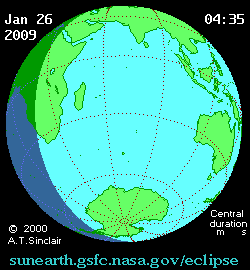
Animated path
Images
.jpg.webp)
Progression from Colombo, Sri Lanka
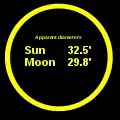 Simulated view of relative diameters of Sun and Moon, as viewed near sunset at the central eclipse path over Borneo.
Simulated view of relative diameters of Sun and Moon, as viewed near sunset at the central eclipse path over Borneo..jpg.webp) George, South Africa, 6:04 UTC
George, South Africa, 6:04 UTC.jpg.webp) Bloemfontein, South Africa, 6:18 UTC
Bloemfontein, South Africa, 6:18 UTC.jpg.webp) Riversdale, South Africa. 6:21 UTC
Riversdale, South Africa. 6:21 UTC.jpg.webp) Cape Town, South Africa, 6:30 UTC
Cape Town, South Africa, 6:30 UTC.jpg.webp) Helpmekaar Kollege, South Africa, 6:54 UTC
Helpmekaar Kollege, South Africa, 6:54 UTC.jpg.webp) Bukit Merah, Singapore, 9:27 UTC
Bukit Merah, Singapore, 9:27 UTC.jpg.webp) Chennai, India, 9:29 UTC
Chennai, India, 9:29 UTC.jpg.webp) Jakarta, Indonesia, 9:41 UTC
Jakarta, Indonesia, 9:41 UTC.jpg.webp) Rajshahi, Bangladesh, 9:43 UTC
Rajshahi, Bangladesh, 9:43 UTC.jpg.webp) Bandung, Indonesia, 9:48 UTC
Bandung, Indonesia, 9:48 UTC.jpg.webp) Subang Jaya, Malaysia, 9:51 UTC
Subang Jaya, Malaysia, 9:51 UTC.jpg.webp) Nugegoda, Sri Lanka, 9:58 UTC
Nugegoda, Sri Lanka, 9:58 UTC.jpg.webp) Bangalore, India, 10:02 UTC
Bangalore, India, 10:02 UTC.jpg.webp) Serang, Indonesia, 10:22 UTC
Serang, Indonesia, 10:22 UTC
Related eclipses
Eclipses of 2009
- An annular solar eclipse on January 26.
- A penumbral lunar eclipse on February 9.
- A penumbral lunar eclipse on July 7.
- A total solar eclipse on July 22.
- A penumbral lunar eclipse on August 6.
- A partial lunar eclipse on December 31.
Tzolkinex
- Preceded: Solar eclipse of December 14, 2001
- Followed: Solar eclipse of March 9, 2016
Half-Saros
- Preceded: Lunar eclipse of January 21, 2000
- Followed: Lunar eclipse of January 31, 2018
Tritos
- Preceded: Solar eclipse of February 26, 1998
- Followed: Solar eclipse of December 26, 2019
Solar Saros 131
- Preceded: Solar eclipse of January 15, 1991
- Followed: Solar eclipse of February 6, 2027
Inex
- Preceded: Solar eclipse of February 16, 1980
- Followed: Solar eclipse of January 5, 2038
Triad
- Preceded: Solar eclipse of March 28, 1922
- Followed: Solar eclipse of November 27, 2095
Solar eclipses 2008–2011
This eclipse is a member of a semester series. An eclipse in a semester series of solar eclipses repeats approximately every 177 days and 4 hours (a semester) at alternating nodes of the Moon's orbit.[3]
| Ascending node | Descending node | |||||
|---|---|---|---|---|---|---|
| Saros | Map | Gamma | Saros | Map | Gamma | |
121 Partial from Christchurch, NZ |
2008 February 07 Annular |
−0.95701 | 126 Novosibirsk, Russia |
2008 August 01 Total |
0.83070 | |
131 Palangka Raya, Indonesia |
2009 January 26 Annular |
−0.28197 | 136 Kurigram, Bangladesh |
2009 July 22 Total |
0.06977 | |
141_Solar_annular_eclipse_of_January_15%252C_2010_in_Bangui%252C_Central_African_Republic.JPG.webp) Bangui, Central African Republic |
2010 January 15 Annular |
0.40016 | 146 Hao, French Polynesia |
2010 July 11 Total |
−0.67877 | |
151 Partial from Vienna, Austria |
2011 January 04 Partial (north) |
1.06265 | 156 | 2011 July 01 Partial (south) |
−1.49171 | |
Partial solar eclipses on June 1, 2011, and November 25, 2011, occur on the next lunar year eclipse set.
Saros 131
It is a part of Saros cycle 131, repeating every 18 years, 11 days, containing 70 events. The series started with partial solar eclipse on August 1, 1125. It contains total eclipses from March 27, 1522 through May 30, 1612 and hybrid eclipses from June 10, 1630 through July 24, 1702, and annular eclipses from August 4, 1720 through June 18, 2243. The series ends at member 70 as a partial eclipse on September 2, 2369. The longest duration of totality was only 58 seconds on May 30, 1612. All eclipses in this series occurs at the Moon’s ascending node.
| Series members 33–70 occur between 1702 and 2369 | ||
|---|---|---|
| 33 | 34 | 35 |
 July 24, 1702 |
 August 4, 1720 |
 August 15, 1738 |
| 36 | 37 | 38 |
 August 25, 1756 |
 September 6, 1774 |
 September 16, 1792 |
| 39 | 40 | 41 |
 September 28, 1810 |
 October 9, 1828 |
 October 20, 1846 |
| 42 | 43 | 44 |
 October 30, 1864 |
 November 10, 1882 |
 November 22, 1900 |
| 45 | 46 | 47 |
 December 3, 1918 |
 December 13, 1936 |
 December 25, 1954 |
| 48 | 49 | 50 |
 January 4, 1973 |
 January 15, 1991 |
 January 26, 2009 |
| 51 | 52 | 53 |
 February 6, 2027 |
 February 16, 2045 |
 February 28, 2063 |
| 54 | 55 | 56 |
 March 10, 2081 |
 March 21, 2099 |
 April 2, 2117 |
| 57 | 58 | 59 |
 April 13, 2135 |
 April 23, 2153 |
 May 5, 2171 |
| 60 | 61 | 62 |
 May 15, 2189 |
 May 27, 2207 |
 June 6, 2225 |
| 63 | 64 | 65 |
 June 18, 2243 |
 June 28, 2261 |
 July 9, 2279 |
| 66 | 67 | 68 |
 July 20, 2297 |
 August 1, 2315 |
 August 11, 2333 |
| 69 | 70 | |
 August 22, 2351 |
 September 2, 2369 | |
Metonic series
The metonic series repeats eclipses every 19 years (6939.69 days), lasting about 5 cycles. Eclipses occur in nearly the same calendar date. In addition, the octon subseries repeats 1/5 of that or every 3.8 years (1387.94 days). All eclipses in this table occur at the Moon's ascending node.
| 21 eclipse events between June 21, 1982, and June 21, 2058 | ||||
|---|---|---|---|---|
| June 21 | April 8–9 | January 26 | November 13–14 | September 1–2 |
| 107 | 109 | 111 | 113 | 115 |
| June 21, 1963 | April 9, 1967 | January 26, 1971 | November 14, 1974 | September 2, 1978 |
| 117 | 119 | 121 | 123 | 125 |
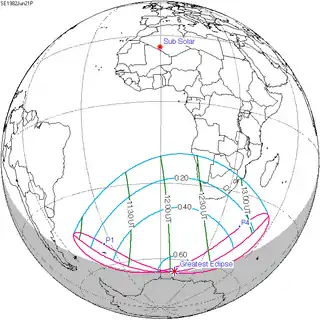 June 21, 1982 |
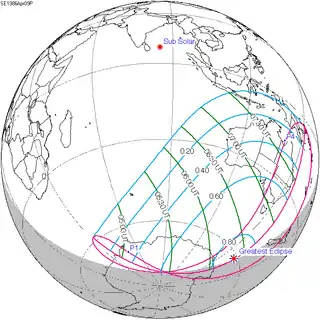 April 9, 1986 |
 January 26, 1990 |
 November 13, 1993 |
 September 2, 1997 |
| 127 | 129 | 131 | 133 | 135 |
 June 21, 2001 |
 April 8, 2005 |
 January 26, 2009 |
 November 13, 2012 |
 September 1, 2016 |
| 137 | 139 | 141 | 143 | 145 |
 June 21, 2020 |
 April 8, 2024 |
 January 26, 2028 |
 November 14, 2031 |
 September 2, 2035 |
| 147 | 149 | 151 | 153 | 155 |
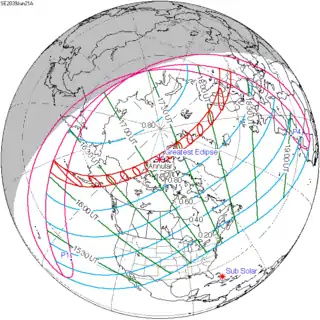 June 21, 2039 |
 April 9, 2043 |
 January 26, 2047 |
 November 14, 2050 |
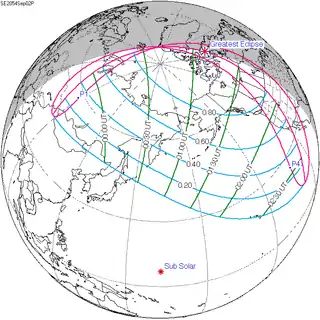 September 2, 2054 |
| 157 | ||||
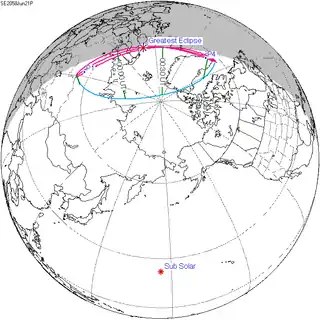 June 21, 2058 | ||||
Notes
- ↑ "Indonesians witness solar eclipse today". The Herald. January 26, 2009. p. 19. Retrieved October 25, 2023 – via Newspapers.com.
- ↑ "Indonesians among the few to witness solar eclipse". Whitehorse Daily Star. January 26, 2009. p. 16. Retrieved October 25, 2023 – via Newspapers.com.
- ↑ van Gent, R.H. "Solar- and Lunar-Eclipse Predictions from Antiquity to the Present". A Catalogue of Eclipse Cycles. Utrecht University. Retrieved October 6, 2018.
References
- Annular Solar Eclipse of 2009 Jan 26, F. Espenak, NASA’s GSFC PDF
- Earth visibility chart and eclipse statistics Eclipse Predictions by Fred Espenak, NASA/GSFC
Photos:
- Spaceweather.com eclipse gallery
- Photos of solar eclipse around the world
- Annular solar eclipse in Indonesia
- Astronomy Picture of the Day, January 28, 2009, A Partial Eclipse Over Manila Bay, Philippines
.jpg.webp)

